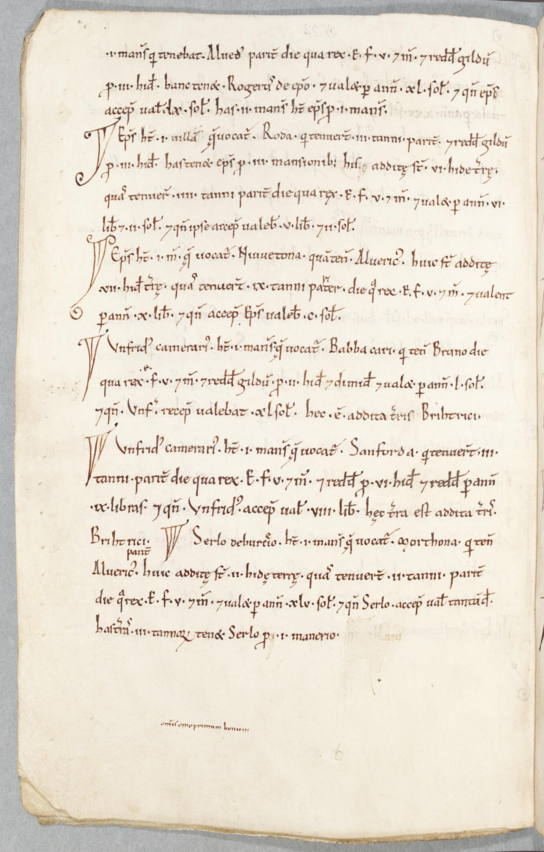In the margins of Exon: Eta’s note

The bottom margin of folio 521 verso is an intriguing corner of the Exon manuscript. We are here in the last of the four booklets which record lists of the Terre Occupate (‘Concealed Lands’, perhaps) of Devon, Cornwall, and Somerset, and about three-quarters of the way through Somerset. The Exon scribal team is nearing completion of this relatively small part of a much larger job of extracting and copying texts from the Domesday survey. One particular scribe has filled the 20 pricked and ruled lines of the page with entries which detail a variety of additions to, subtractions from, and rearrangement of, manors in Somerset. The last entry on the page registers the addition of 2 hides to Serle de Burcy’s manor of Moreton. On the facing page, the same scribe will start writing about Bishop Maurice of London’s tenure of the church of St Andrew in Ilchester. But first, he writes something in the deep empty bottom margin of the completed page, mid-way down the space and set somewhat left of centre. He writes neatly, and of course in Latin. He uses tiny letters, not half the height of the rest of his writing on the page, but they are perfectly legible to himself and to anyone else in the room who might care to look. What he writes is the four words
om[n]is omo primum bonum

He uses a contraction mark over the m of the first word to show he is missing out the following letter. He omits the initial h of homo (‘man’) because he is French, we suppose a Norman, and perhaps one brought to England for the purpose when the requirements of the Domesday survey demanded so much mechanical copying. We are calling this scribe Eta, reusing the names for the Exon scribes devised from the letters of the Greek alphabet by Colin Flight, but we know nothing about him except for his role in the Exon team.
In the 1816 edition of Exon, Eta’s marginal note appears mistranscribed as the unintelligible omis omu primum bonum. But the phrase is packed with meaning, because it is a quotation from the gospel of St John, where chapter 2 records the first of Jesus’s miracles, turning water into wine at the wedding feast at Cana. In the gospel story, the wine has run out and Jesus’s mother begs him for a miracle. He obliges by instructing the servants to fill up half a dozen 20- or 30-gallon water-jars, which when poured miraculously hold wine, and the party goes on. The master of the feast, not knowing the true origin of the new wine, compliments the bridegroom (verse 10)
omnis homo primum bonum vinum ponit et cum inebriati fuerint tunc id quod deterius est tu servasti bonum vinum usque adhuc [Vulgate]
‘Everyone else serves the best wine first, and the poorer wine only when the guests have drunk freely; but you have kept the best wine till now’ [Revised English Bible]
The snippet of four words written by Eta is meaningless as Latin, for lack of a noun attached to the adjective bonum, or a verb saying what omnis homo does, but as a tag it would have brought to the mind of every literate clerk the whole of the chapter and all the teaching about Christ’s ministry that went with it.
What meaning might it have had for Eta at the moment of writing, marginally but hardly inconspicuously, among his work for the day? We can only speculate. It might have meant . . .
. . . I need a drink . . . The verse refers to wine, and in many biblical verses good wine was a metaphor for the goodness of life, besides standing in John 2: 10 for the renewal of the Old Testament covenant between God and mankind.
. . . Nearly finished . . . The longer quotation might be taken to refer proverbially to the fact that, sometimes, the best things come last, and so are worth waiting for.
. . . Must remember . . . What? That I’m in charge of the wine at dinner? To tell Epsilon not to drink too much?
Or even . . . Sure, happy to read the gospel lection next Sunday, seeing as Epsilon’s called in sick again . . . let me just jot down something to remind me of the reading.
The last goes beyond mere speculation into pure fantasy, but it is enticing to think that we might be able to associate a time of year with Eta’s biblical tag. In the eleventh century John chapter 2 was read in an annual cycle of lections in churches across Latin Europe on the second Sunday in Epiphany, still within the special period of the Nativity. It would be marvellous if we knew for sure that this page of the Somerset Terre Occupate, a text which soon made its way into Exon’s account of Somerset fiefs and manors, and thence into Great Domesday Book, was being written a few days before 17 January 1087 . . . but of course we don’t. Other suggestions about Omnis omo primum bonum — with any degree of plausibility — are welcome to chris.lewis@sas.ac.uk.
Share on Twitter Share on Facebook
Comments